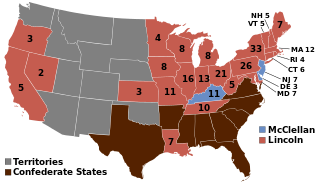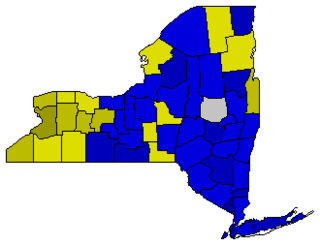
The 1876 United States presidential election was the 23rd quadrennial presidential election, held on Tuesday, November 7, 1876. Incumbent Republican president Ulysses S. Grant declined to run for a third term, so the party chose Rutherford B. Hayes, the governor of Ohio, as its nominee. The Democratic Party nominated New York governor Samuel J. Tilden as their nominee. It was one of the most contentious presidential elections in American history. Its resolution involved negotiations between the Republicans and Democrats, resulting in the Compromise of 1877, and on March 2, 1877, the counting of electoral votes by the House and Senate occurred, confirming Hayes as president. It was the second of five U.S. presidential elections in which the winner did not win a plurality of the national popular vote. This is the first time it happened since 1824, and the only time that a candidate won an overall majority in the popular vote but did not win the presidency.

The 1796 United States presidential election was the third quadrennial presidential election of the United States. It was held from Friday, November 4 to Wednesday, December 7, 1796. It was the first contested American presidential election, the first presidential election in which political parties played a dominant role, and the only presidential election in which a president and vice president were elected from opposing tickets. Incumbent vice president John Adams of the Federalist Party defeated former secretary of state Thomas Jefferson of the Democratic-Republican Party.

The 1832 United States presidential election was the 12th quadrennial presidential election, held from Friday, November 2 to Wednesday, December 5, 1832. Incumbent president Andrew Jackson, candidate of the Democratic Party, defeated Henry Clay, candidate of the National Republican Party.

The 1852 United States presidential election was the 17th quadrennial presidential election, held on Tuesday, November 2, 1852. Democrat Franklin Pierce defeated Whig nominee General Winfield Scott. A third party candidate from the Free Soil party, John P. Hale, also ran and came in third place, but got no electoral votes.

The 1860 United States presidential election was the 19th quadrennial presidential election, held on Tuesday, November 6, 1860. In a four-way contest, the Republican Party ticket of Abraham Lincoln and Hannibal Hamlin won a national popular plurality, a popular majority in the North where states already had abolished slavery, and a national electoral majority comprising only Northern electoral votes. Lincoln's election thus served as the main catalyst of the states that would become the Confederacy seceding from the Union. This marked the first time that a Republican was elected president. It was also the first presidential election in which both major party candidates were registered in the same home state; the others have been in 1904, 1920, 1940, 1944, and 2016.

The 1864 United States presidential election was the 20th quadrennial presidential election. It was held on Tuesday, November 8, 1864. Near the end of the American Civil War, incumbent President Abraham Lincoln of the National Union Party easily defeated the Democratic nominee, former General George B. McClellan, by a wide margin of 212–21 in the electoral college, with 55% of the popular vote. For the election, the Republican Party and some Democrats created the National Union Party, especially to attract War Democrats.
Electoral fusion in the United States is an arrangement where two or more U.S. political parties on a ballot list the same candidate, allowing that candidate to receive votes on multiple party lines in the same election.

The 1860 United States presidential election in Missouri took place on November 2, 1860, as part of the 1860 United States presidential election. Voters chose nine representatives, or electors to the Electoral College, who voted for president and vice president.

The 2000 United States presidential election in California took place on November 7, 2000, as part of the wider 2000 United States presidential election. Voters chose 54 representatives, or electors to the Electoral College, who voted for president and vice president.

The 1860 United States presidential election in Pennsylvania took place on November 6, 1860, as part of the 1860 United States presidential election. Voters chose 27 representatives, or electors to the Electoral College, who voted for president and vice president.

The 1832 United States presidential election in New York took place between November 2 and December 5, 1832, as part of the 1832 United States presidential election. Voters chose 42 representatives, or electors to the electoral college, who voted for president and vice president.

The 1860 United States presidential election in Virginia took place on November 6, 1860, as part of the 1860 United States presidential election. Voters chose 15 representatives, or electors to the Electoral College, who voted for president and vice president.

Following is a table of United States presidential elections in New Jersey, ordered by year. Since its admission to statehood in 1787, New Jersey has participated in every U.S. presidential election.

The 1860 United States presidential election in Louisiana took place on November 6, 1860, as part of the 1860 United States presidential election. Louisiana voters chose six representatives, or electors, to the Electoral College, who voted for president and vice president.

The 1860 United States presidential election in Rhode Island took place on November 2, 1860, as part of the 1860 United States presidential election. Voters chose four electors of the Electoral College, who voted for president and vice president.

The 1860 United States presidential election in New Jersey took place on 6 November 1860, as part of the 1860 United States presidential election. Voters in New Jersey chose seven electors of the Electoral College, who voted for President and Vice President. New Jersey voters voted for each elector individually, and thus could split their votes. All seven electors were chosen in a single at-large election. That is, each voter voted for up to seven candidates, and the seven candidates with highest vote counts were elected.

The 1860 United States presidential election in Delaware took place on November 6, 1860, as part of the 1860 United States presidential election. State voters chose three representatives, or electors, to the Electoral College, who voted for president and vice president.

The 1892 United States presidential election in North Dakota took place on November 8, 1892. All contemporary 44 states were part of the 1892 United States presidential election. Voters chose three electors to the Electoral College, which selected the president and vice president.





















